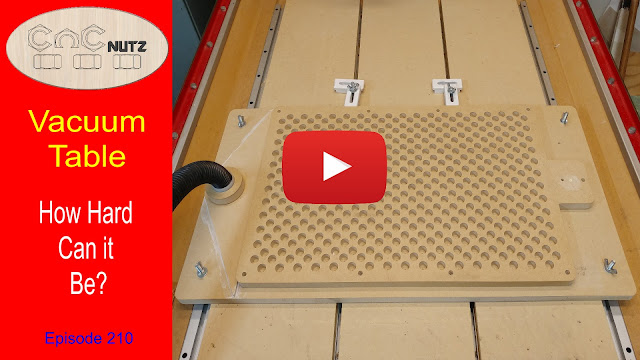Suggestions
Use a non porus material for the base like Plastic sign board or HDPE
Use Malamine coated MDF and seal the edges with edge banding.
Seal the MDF with paint, shellac or similar product.
Leave the vacuum running while painting to pull the paint deeper into the MDF to get a better seal.
Cover the MDF with a vinyl or similar coating.
Here's the final result.
Getting a better seal
Even with the table sealed and maintaining the vacuum the issue of sealing the material to the tabletop remains. With the table flat there are still small paths for the vacuum to escape due to material imperfections. What is needed is come form of gasket to get the good seal and many solutions use Orings. these won't work if you want to cut through the material as I do and making special vacuum bases per project isn't practical.
I remember Micheal, who visited me about 18 months ago, telling me he used some form of material between his vacuum table top and the stock to get a better seal. I can't remember what it was but I had an idea to put a piece of newspaper on the table surface and see how that went. To my surprise and great pleasure it makes a huge difference to the holding power of the vacuum. It will reduse the air flow through the unused holes while alloing the vacuum to build up under the stock. I will also provides a little clearance between the tabletop and the bottom of the stock so when cutting through the cutter won't touch the table surface all going well.
Small Holes
The use of the small holes in each pod looks to be just ideal. The vacuum pulls very quickly but even with most of the pods uncovered or covered with paper the vacuum seems to have good holding power. Had I put 1/4" holes in in each pod the uncovering of just 1 or 2 of them would have meant loss of vacuum on the entire table. It also eliminates the need for sectioning off areas of the tabletop though if I had made it larger it mag have been necessary.
Vaccum source
This is the hardest problem to solve and something you need to be aware of.
Vacuum cleaners are not made to but used with vacuum tables. While they obviously work and are used by many people the restricton of the hose robs the cleaner of the necessary cooling air it needs to keep the motor cool. If you don't cool the motor it WILL burn out. The vacuum I used in part 2 of this video is made by Festool but has been superceeded. It has seperate cooling for the motor so is a good option for this project.
The motor cooling outlet can bee seen as the grill on the front of the cleaner and the exhaust for the vacuum is visible on the left hand side of the cleaner. when you block the hose the exhause on the left stops but the one at the front keeps blowing. the only down side of these is the cost but it is a professional unit made to collect fine sanding dust etc. At over $1000 for one of these I think I will borrow my brothers on the occassions I need it.
Other options are real vacuum pumps though I dont know what size pump is really needed for this application. Ebay has some cheep ones at less than $100 USD but whether it will work with a midsize table top I don't know.
The other suggestion was to convert an air compressor to pull a vacuum. After all while it blows at one end it has to suck at the other. I'm told it can be done quite simply and not loose the compressor function.
I actually have a 2 stage vacuum pump that I used to use as a compressor but its piston seals are damaged and it will not pull a vacuum any more. If I can find a suitable material I may be able to repair it but in the meantime the current setup will work just fine.
Please be aware of ordinary vacuum cleaner limitations.
Well that is all for this project. I am looking forward to using it on an upcoming video so until next time
Cheers
Peter




